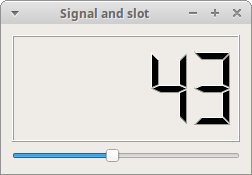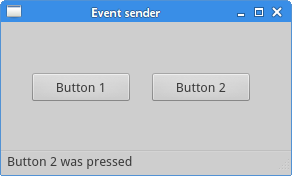在这部分PyQt5编程教程中,我们探索应用中事件和信号的发生。
事件
所有的GUI应用都是事件驱动的。事件主要由应用的用户操作产生的。但是事件可能由其他条件触发,比如:一个网络连接,一个窗口管理器,一个定时器,这些动作都可能触发事件的产生。当我们调用应用的exec_()方法时,应用进入了主循环。主循环用于检测事件的产生并且将事件送到用于处理的对象中去。
在事件模型,有三个参与者
- 事件源
- 事件对象
- 事件目标
事件源是状态发生改变的对象。它产生了事件。事件对象(evnet)封装了事件源中的状态变化。事件目标是想要被通知的对象。事件源对象代表了处理一个事件直到事件目标做出响应的任务。
PyQt5有一个独一无二的信号和槽机制来处理事件。信号和槽用于对象之间的通信。当指定事件发生,一个事件信号会被发射。槽可以被任何Python脚本调用。当和槽连接的信号被发射时,槽会被调用。
信号 & 槽
这个例子演示了PyQt5中的信号和槽的使用。
|
1
2
3
4
5
6
7
8
9
10
11
12
13
14
15
16
17
18
19
20
21
22
23
24
25
26
27
28
29
30
31
32
33
34
35
36
37
38
39
40
41
42
43
44
45
46
47
48
49
50
|
#!/usr/bin/python3
# -*- coding: utf-8 -*-
"""
ZetCode PyQt5 tutorial
In this example, we connect a signal
of a QSlider to a slot of a QLCDNumber.
author: Jan Bodnar
website: zetcode.com
last edited: January 2015
"""
import
sys
from
PyQt5.QtCore
import
Qt
from
PyQt5.QtWidgets
import
(QWidget, QLCDNumber, QSlider,
QVBoxLayout, QApplication)
class
Example(QWidget):
def
__init__(
self
):
super
().__init__()
self
.initUI()
def
initUI(
self
):
lcd
=
QLCDNumber(
self
)
sld
=
QSlider(Qt.Horizontal,
self
)
vbox
=
QVBoxLayout()
vbox.addWidget(lcd)
vbox.addWidget(sld)
self
.setLayout(vbox)
sld.valueChanged.connect(lcd.display)
self
.setGeometry(
300
,
300
,
250
,
150
)
self
.setWindowTitle(
'Signal & slot'
)
self
.show()
if
__name__
=
=
'__main__'
:
app
=
QApplication(sys.argv)
ex
=
Example()
sys.exit(app.exec_())
|
在我们的例子中,我们显示了一个QtGui.QLCDNumber和一个QtGui.QSlider类。我们拖动滑块条的把手,lcd数字会变化。
|
1
|
sld.valueChanged.connect(lcd.display)
|
这里,我们将滑块条的valueChanged信号和lcd数字显示的display槽连接在一起。
发送者是一个发送了信号的对象。接受者是一个接受了信号的对象。槽是对信号做出反应的方法。
 Figure: Signal & slot
Figure: Signal & slot
重写事件处理函数
PyQt中的事件处理通常通过重写事件处理函数来处理。
|
1
2
3
4
5
6
7
8
9
10
11
12
13
14
15
16
17
18
19
20
21
22
23
24
25
26
27
28
29
30
31
32
33
34
35
36
37
38
39
40
41
42
43
44
45
|
#!/usr/bin/python3
# -*- coding: utf-8 -*-
"""
ZetCode PyQt5 tutorial
In this example, we reimplement an
event handler.
author: Jan Bodnar
website: zetcode.com
last edited: January 2015
"""
import
sys
from
PyQt5.QtCore
import
Qt
from
PyQt5.QtWidgets
import
QWidget, QApplication
class
Example(QWidget):
def
__init__(
self
):
super
().__init__()
self
.initUI()
def
initUI(
self
):
self
.setGeometry(
300
,
300
,
250
,
150
)
self
.setWindowTitle(
'Event handler'
)
self
.show()
def
keyPressEvent(
self
, e):
if
e.key()
=
=
Qt.Key_Escape:
self
.close()
if
__name__
=
=
'__main__'
:
app
=
QApplication(sys.argv)
ex
=
Example()
sys.exit(app.exec_())
|
在我们的例子中,我们重写了keyPressEvent()事件处理函数。
|
1
2
3
4
|
def
keyPressEvent(
self
, e):
if
e.key()
=
=
Qt.Key_Escape:
self
.close()
|
如果我们点击了Esc按钮,应用将会被终止。
事件发送者
有时需要方便的知道哪一个组件是信号发送者。因此,PyQt5拥有了sender()方法来解决这个问题。
|
1
2
3
4
5
6
7
8
9
10
11
12
13
14
15
16
17
18
19
20
21
22
23
24
25
26
27
28
29
30
31
32
33
34
35
36
37
38
39
40
41
42
43
44
45
46
47
48
49
50
51
52
53
54
55
|
#!/usr/bin/python3
# -*- coding: utf-8 -*-
"""
ZetCode PyQt5 tutorial
In this example, we determine the event sender
object.
author: Jan Bodnar
website: zetcode.com
last edited: January 2015
"""
import
sys
from
PyQt5.QtWidgets
import
QMainWindow, QPushButton, QApplication
class
Example(QMainWindow):
def
__init__(
self
):
super
().__init__()
self
.initUI()
def
initUI(
self
):
btn1
=
QPushButton(
"Button 1"
,
self
)
btn1.move(
30
,
50
)
btn2
=
QPushButton(
"Button 2"
,
self
)
btn2.move(
150
,
50
)
btn1.clicked.connect(
self
.buttonClicked)
btn2.clicked.connect(
self
.buttonClicked)
self
.statusBar()
self
.setGeometry(
300
,
300
,
290
,
150
)
self
.setWindowTitle(
'Event sender'
)
self
.show()
def
buttonClicked(
self
):
sender
=
self
.sender()
self
.statusBar().showMessage(sender.text()
+
' was pressed'
)
if
__name__
=
=
'__main__'
:
app
=
QApplication(sys.argv)
ex
=
Example()
sys.exit(app.exec_())
|
在我们的例子中,我们有两个按钮。在buttonClikced()方法中,我们调用sender()方法来判断哪一个按钮是我们按下的。
|
1
2
|
btn1.clicked.connect(
self
.buttonClicked)
btn2.clicked.connect(
self
.buttonClicked)
|
两个按钮都连接到了同一个槽中。
|
1
2
3
4
|
def
buttonClicked(
self
):
sender
=
self
.sender()
self
.statusBar().showMessage(sender.text()
+
' was pressed'
)
|
我们调用sender()方法判断发送信号的信号源是哪一个。然后在应用的状态栏上显示被按下的按钮的标签内容。
 Figure: Event sender
Figure: Event sender
发送信号
从QObejct生成的对象可以发送信号。在下面的例子中我们将会看到怎样去发送自定义的信号。
|
1
2
3
4
5
6
7
8
9
10
11
12
13
14
15
16
17
18
19
20
21
22
23
24
25
26
27
28
29
30
31
32
33
34
35
36
37
38
39
40
41
42
43
44
45
46
47
48
49
50
51
52
|
#!/usr/bin/python3
# -*- coding: utf-8 -*-
"""
ZetCode PyQt5 tutorial
In this example, we show how to emit a
signal.
author: Jan Bodnar
website: zetcode.com
last edited: January 2015
"""
import
sys
from
PyQt5.QtCore
import
pyqtSignal, QObject
from
PyQt5.QtWidgets
import
QMainWindow, QApplication
class
Communicate(QObject):
closeApp
=
pyqtSignal()
class
Example(QMainWindow):
def
__init__(
self
):
super
().__init__()
self
.initUI()
def
initUI(
self
):
self
.c
=
Communicate()
self
.c.closeApp.connect(
self
.close)
self
.setGeometry(
300
,
300
,
290
,
150
)
self
.setWindowTitle(
'Emit signal'
)
self
.show()
def
mousePressEvent(
self
, event):
self
.c.closeApp.emit()
if
__name__
=
=
'__main__'
:
app
=
QApplication(sys.argv)
ex
=
Example()
sys.exit(app.exec_())
|
我们创建一个新的信号叫做closeApp。当触发鼠标点击事件时信号会被发射。信号连接到了QMainWindow的close()方法。
|
1
2
3
|
class
Communicate(QObject):
closeApp
=
pyqtSignal()
|
信号使用了pyqtSignal()方法创建,并且成为外部类Communicate类的属性。
|
1
2
|
self
.c
=
Communicate()
self
.c.closeApp.connect(
self
.close)
|
把自定义的closeApp信号连接到QMainWindow的close()槽上。
|
1
2
3
|
def
mousePressEvent(
self
, event):
self
.c.closeApp.emit()
|
当我们在窗口上点击一下鼠标,closeApp信号会被发射。应用中断。
这部分的PyQt5教程中,我们概览了信号了槽机制。